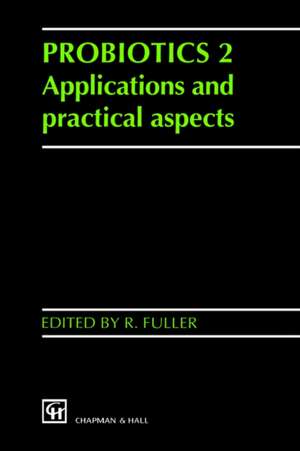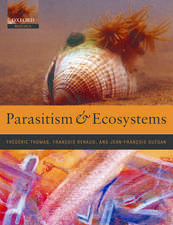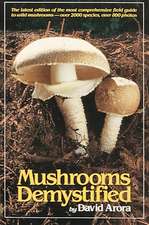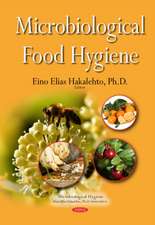Probiotics 2: Applications and practical aspects
Editat de R. Fulleren Limba Engleză Hardback – 30 iun 1997
| Toate formatele și edițiile | Preț | Express |
|---|---|---|
| Paperback (1) | 941.38 lei 6-8 săpt. | |
| SPRINGER NETHERLANDS – 4 oct 2012 | 941.38 lei 6-8 săpt. | |
| Hardback (1) | 948.79 lei 6-8 săpt. | |
| SPRINGER NETHERLANDS – 30 iun 1997 | 948.79 lei 6-8 săpt. |
Preț: 948.79 lei
Preț vechi: 1157.06 lei
-18% Nou
Puncte Express: 1423
Preț estimativ în valută:
181.54€ • 189.57$ • 149.92£
181.54€ • 189.57$ • 149.92£
Carte tipărită la comandă
Livrare economică 15-29 aprilie
Preluare comenzi: 021 569.72.76
Specificații
ISBN-13: 9780412736100
ISBN-10: 0412736101
Pagini: 212
Ilustrații: IX, 212 p.
Dimensiuni: 155 x 235 x 19 mm
Greutate: 0.54 kg
Ediția:1997
Editura: SPRINGER NETHERLANDS
Colecția Springer
Locul publicării:Dordrecht, Netherlands
ISBN-10: 0412736101
Pagini: 212
Ilustrații: IX, 212 p.
Dimensiuni: 155 x 235 x 19 mm
Greutate: 0.54 kg
Ediția:1997
Editura: SPRINGER NETHERLANDS
Colecția Springer
Locul publicării:Dordrecht, Netherlands
Public țintă
ResearchCuprins
1 Introduction.- 1.1 Development of Commercial Preparations.- 1.2 Factors Affecting the Response.- 1.3 Future Developments.- 1.4 Conclusions.- 1.5 References.- 2 Probiotics and Intestinal Infections.- 2.1 Introduction.- 2.2 Human Colonic Microbiota and Homeostasis.- 2.3 Infections of the Intestinal Tract.- 2.4 Attachment.- 2.5 Use of Probiotics against Intestinal Infections.- 2.6 Probiotics and Viral Infections of the Gastrointestinal Tract.- 2.7 Modulation of the Host Response to Infection.- 2.8 Effects of Probiotics in Infants.- 2.9 Prebiotics and Synbiotics.- 2.10 References.- 3 Antibiotic-Associated Diarrhoea: Treatments by Living Organisms given by the Oral Route (Probiotics).- 3.1 Introduction.- 3.2 Antibiotic-Associated Diarrhoea and Pseudomembranous Colitis.- 3.3 Treatments by Living Organisms.- 3.4 Search for New Oral Treatments by Probiotics.- 3.5 Acknowledgements.- 3.6 References.- 4 Lactose Maldigestion.- 4.1 Introduction.- 4.2 Lactose Metabolism.- 4.3 Methods to Study Lactose Digestion.- 4.4 Digestion and Tolerance of Fermented Dairy Products in Lactose-Intolerant Subjects.- 4.5 Mechanisms for the Better Tolerance and Digestion of Lactose from Fermented Dairy Products.- 4.6 Clinical Applications of Probiotics or Fermented Milks in the Field of Lactose Maldigestion or Intolerance.- 4.7 Comments and Conclusions.- 4.8 References.- 5 Antimutagenic and Antitumour Activities of Lactic Acid Bacteria.- 5.1 Introduction.- 5.2 Antimutagenic Activity of Lactic Acid Bacteria.- 5.3 Antitumour Activity of Lactic Acid Bacteria.- 5.4 References.- 6 Stimulation of Immunity by Probiotics.- 6.1 Introduction.- 6.2 Microflora, Probiotics and Immunity.- 6.3 Endogenous Microflora.- 6.4 Morphology of Gut-Associated Lymphoid Tissue.- 6.5 Intra-Epithelial Lymphocyte Compartment.- 6.6 Lamina Propria Lymphocyte Compartment.- 6.7 Antigen Presentation in the Gut.- 6.8 Effector Response in the Gut.- 6.9 Modulation of Gut Functions by Immune Networks.- 6.10 Modulation of Cytokine Production by Probiotics.- 6.11 Modulation of Gut-Associated Lymphoid Tissue by Probiotics.- 6.12 Modulation of Macrophage Functions by Probiotics.- 6.13 Modulation of Resistance towards Salmonella Typhimurium by Probiotics.- 6.14 Modulation of Autoimmunity by Probiotics.- 6.15 Role of Probiotics in the Treatment of Human Infections.- 6.16 Pathogenic Potential of Probiotics.- 6.17 References.- 7 Probiotics in Cattle.- 7.1 Introduction.- 7.2 Baby Calves.- 7.3 Beef Cattle.- 7.4 Lactating Cows.- 7.5 Market Penetration of Probiotics.- 7.6 How do Probiotics Work in Cattle?.- 7.7 Conclusions.- 7.8 References.- 8 Intervention Strategies: The use of Probiotics and Competitive Exclusion Microfloras against Contamination with Pathogens in Pigs and Poultry.- 8.1 Introduction.- 8.2 Intestinal Flora and Gut Metabolism.- 8.3 Microflora and Colonization Resistance.- 8.4 Use of Probiotics.- 8.5 Use of Competitive Exclusion Microfloras in Poultry.- 8.6 Summary.- 8.7 References.
Notă biografică
Roy Fuller is a private consultant in intestinal microecology, operating from Reading, UK










